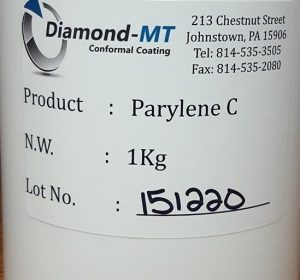Different Types of Parylene
Posted by Sean Horn
Friday, October 7, 2016 7:30
@ 7:30 AM
Parylene Varietals: Matching Material to Purpose
A common generic name for Poly-para-xylylene, parylene forms a protective plastic film when applied to substrate surfaces. Application is achieved through a chemical vapor deposition (CVD) process in a vacuum, as a gas to targeted substrate surfaces.
Parylene films are very adaptable, protecting substrates with a dependable barrier against acids, caustic solutions, dust, water vapor, and numerous other contaminants. Their exceptional electrical insulation exhibits low dielectric constancy and high tension strain. Coverage is pinhole-free, and suitable for complex coating of surfaces characterized by crevices, exposed internal areas, or sharp edges.
Different types of parylene include N, C, D, HT, AF-4, and F; each has a specified utility distinguished by different chemical, electrical and physical properties. Depending on the specific use, parylene conformal coatings can be effective in the range of 0.1 – 76 microns’ thickness, far finer than liquid coating materials.
Types of Parylene
Among the prominent parylene types are:
Parylene N
Type N is the basic member of the poly-p-xylylene series, and therefore the most natural, assuming the form of a completely linear, highly crystalline material; each molecule consists of a carbon-hydrogen combination. In comparison to other parylene types, N’s low dielectric constant and dissipation values encourage use in high frequency applications. Its melting point of 420°C is higher than either Types C and D. N generates exceptional vacuum stability as conformal coating, registering total weight-loss levels of 0.30% at 49.4° C, and 10 -6 torr (1 torr = 1/760 of the standard atmospheric pressure [SAP = 1 mm Hg]).
 Parylene C
Parylene C
The most widely used parylene for conformal coatings, Parylene C is a poly-monochoro para-xylene, produced from dimer material, with one chlorine group per repeat unit on its main-chain phenyl ring. That is, although C is a carbon-hydrogen combination like Type N, each molecule possesses a chlorine atom in place of one hydrogen atom. Type C films generate exceptional protection from corrosive gases, due to low chemical, moisture, and vapor permeability. Highly moisture resistant, it deposits quickly on most substrate surfaces, at room temperature through parylene’s unique CVD process. Type C’s lesser lower throw-capability reduces crevice-penetration activity, while providing effective coating protection through ongoing exposure at 100° C, in oxygen-dominated atmospheres for 100,000 hours (approximately a decade – 10 years). C’s vacuum stability is verified with performance ratings of 0.12% total weight-loss, at the same standards as N (49.4° C/10 -6 torr).
Parylene D
Types C and D originate from the same monomer. Similar to C, D’s composition differs from Type N; it contains two atoms of chlorine in place of two hydrogen atoms. Although it can withstand temperatures as high as 125°C, D lacks sufficient biocompatibility for wide use in medical devices. Parylene D offers effective coating protection at 134° C through ongoing exposure at 100° C in oxygen-dominated atmospheres for 100,000 hours.
Parylene AF-4
With higher oxidative resistance and UV stability than other parylene types, AF-4 has specialized uses. However, its precursor requires a three-step synthesis process, limiting yield while increasing production costs.
Parylene F
Type F is fluorinated, characterized by fluorine atoms on its aromatic ring; its use can significantly lower coating capacitation, reducing a coated surface’s electrical charge during operation. F demonstrates a greater throw-capability than Type C, with a higher reduction in crevice penetration-activity. It also deposits more slowly than C and most other parylene types, which utilize CVD processes. The limited access to F dimer currently impede its commercial application.
Conclusion
Parylene condenses on substrate surfaces in a polycrystalline fashion, generally through vacuum CVD. The result is a truly conformal and pinhole free protective substrate coating. Parylenes N and C account for the majority of parylene’s current commercial applications. In comparison, deposition rates for other parylene types are significantly slower, diminishing productivity while increasing cost.
If you’re looking for parylene coating services, look no further than the experts at Diamond-MT. We have over 30 years’ of experience providing high-quality coating services for all industries. Contact us to day for more information or to request a quote.
To learn more about parylene, download our introductory whitepaper at:
Download our guide on Parylene 101
Comments
Homepage 4/17/2020. 10:17:10 AM
... [Trackback] [...] Informations on that Topic: blog.paryleneconformalcoating.com/whats-the-difference-between-potting-and-conformal-coating/ [...]

londondrugscanada.bigcartel.comlondon-drugs 4/17/2020. 10:17:10 AM
cialis uk https://londondrugscanada.bigcartel.com/london-drugs This is nicely expressed. !